Welcome to DU!
The truly grassroots left-of-center political community where regular people, not algorithms, drive the discussions and set the standards.
Join the community:
Create a free account
Support DU (and get rid of ads!):
Become a Star Member
Latest Breaking News
General Discussion
The DU Lounge
All Forums
Issue Forums
Culture Forums
Alliance Forums
Region Forums
Support Forums
Help & Search
Celerity
Celerity's Journal
Celerity's Journal
January 5, 2022
https://www.vanityfair.com/news/2022/01/melania-trump-hat-nft-auction

When Melania Trump announced last month that that she was getting into the NFT business, starting with a digital “watercolor” of her eyes and then expanding her offerings to include other non-fungible tokens for sale via a “one-of-a-kind auction of historical importance,” ours and many people’s initial response was “What?” When had the former first lady ever expressed an iota of interest in blockchain technology? Why was she flooding the universe with portraits of her chilling gaze? What…was happening?
Of course, we quickly realized that the whole thing made perfect sense, as it was another classic Trump grift. For one thing, as The Independent wrote at the time, it was (and remains) “unclear exactly what value investors in the NFT are getting for their money.” For another, though a press release noted that a portion of the proceeds from the sale would “assist children aging out of the foster care system by way of economic empowerment and with expanded access to resources needed to excel in the fields of computer science and technology,” Melania and company did not say exactly how big that portion will be, and the former first lady’s office chose not to respond to The Washington Post’s questions about the actual figure. In other words, it’s entirely possible a significant portion of the proceeds could go to directly to Melania Trump, which would be in keeping with Donald Trump’s outlook on charity, which has historically involved bold claims “that don’t always add up” and “persistently illegal conduct.”
Anyway, Mel is at again. Per CNN:
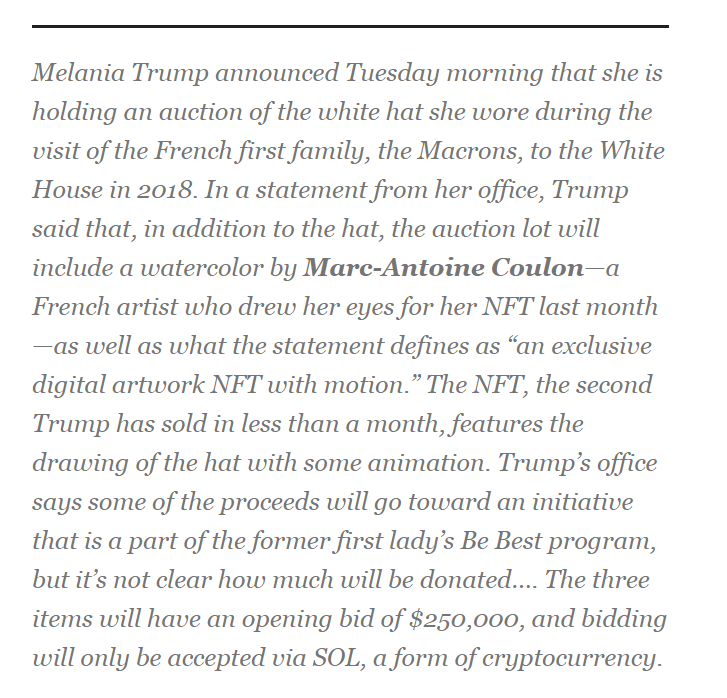
While the white hat is certainly a piece of history, it’s not necessarily the kind that screams “BE BEST, KIDS.” As CNN reminds us, it was worn in April 2018, “a handful of weeks after scandalous headlines about the former president’s alleged extramarital affairs.” Then again, it’s probably more appropriate than raising money off of the “I Really Don’t Care. Do U?” jacket the former first lady wore during a trip to tour a detention center housing 55 migrant children.
CNN says that it has “sought clarity numerous times from Trump’s spokesperson about the ‘portion of the proceeds’” that will go to charity, requests that have apparently gone unanswered. A statement about the auction says Melania will “grant the opening round of scholarships to recipients during the first quarter of 2022,” though further details about the scholarships have not yet been revealed. In related news, remember when The Washington Post reported that Donald Trump offered a grieving military father $25,000 and said he would have his staff establish an online fundraiser for the family, neither of which happened, and then months later, the man received a check dated the day the Post story was published? Not sure what made us think of that. Anyway, happy bidding!
snip
Melania Trump's 2022 Resolution: Grift Like There's No Tomorrow
The former first lady is once again asking people to give her money.https://www.vanityfair.com/news/2022/01/melania-trump-hat-nft-auction

When Melania Trump announced last month that that she was getting into the NFT business, starting with a digital “watercolor” of her eyes and then expanding her offerings to include other non-fungible tokens for sale via a “one-of-a-kind auction of historical importance,” ours and many people’s initial response was “What?” When had the former first lady ever expressed an iota of interest in blockchain technology? Why was she flooding the universe with portraits of her chilling gaze? What…was happening?
Of course, we quickly realized that the whole thing made perfect sense, as it was another classic Trump grift. For one thing, as The Independent wrote at the time, it was (and remains) “unclear exactly what value investors in the NFT are getting for their money.” For another, though a press release noted that a portion of the proceeds from the sale would “assist children aging out of the foster care system by way of economic empowerment and with expanded access to resources needed to excel in the fields of computer science and technology,” Melania and company did not say exactly how big that portion will be, and the former first lady’s office chose not to respond to The Washington Post’s questions about the actual figure. In other words, it’s entirely possible a significant portion of the proceeds could go to directly to Melania Trump, which would be in keeping with Donald Trump’s outlook on charity, which has historically involved bold claims “that don’t always add up” and “persistently illegal conduct.”
Anyway, Mel is at again. Per CNN:

While the white hat is certainly a piece of history, it’s not necessarily the kind that screams “BE BEST, KIDS.” As CNN reminds us, it was worn in April 2018, “a handful of weeks after scandalous headlines about the former president’s alleged extramarital affairs.” Then again, it’s probably more appropriate than raising money off of the “I Really Don’t Care. Do U?” jacket the former first lady wore during a trip to tour a detention center housing 55 migrant children.
CNN says that it has “sought clarity numerous times from Trump’s spokesperson about the ‘portion of the proceeds’” that will go to charity, requests that have apparently gone unanswered. A statement about the auction says Melania will “grant the opening round of scholarships to recipients during the first quarter of 2022,” though further details about the scholarships have not yet been revealed. In related news, remember when The Washington Post reported that Donald Trump offered a grieving military father $25,000 and said he would have his staff establish an online fundraiser for the family, neither of which happened, and then months later, the man received a check dated the day the Post story was published? Not sure what made us think of that. Anyway, happy bidding!
snip
January 5, 2022
https://www.thedailybeast.com/the-next-big-covid-19-variant-could-be-a-triple-whammy-nightmare
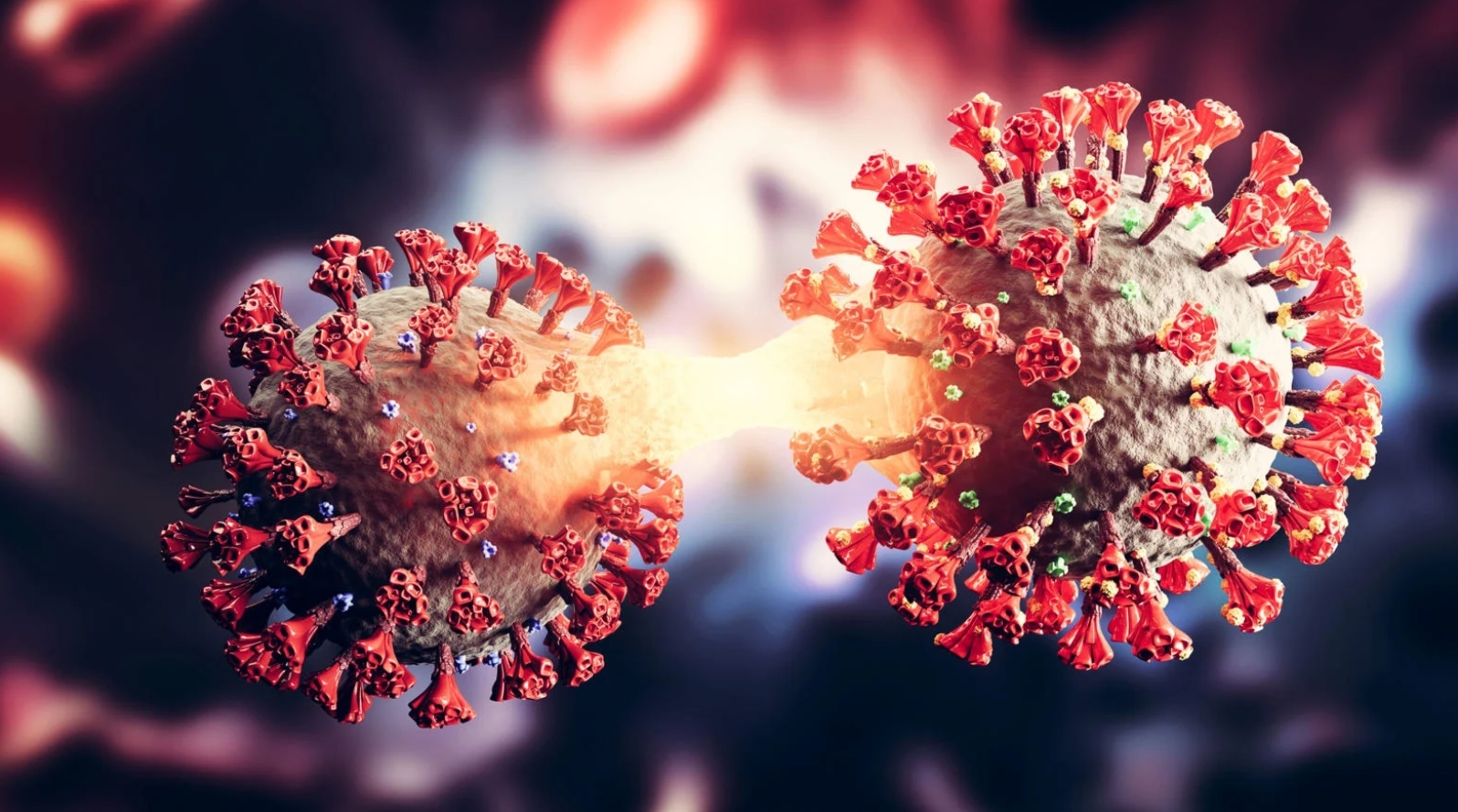
Even as daily new COVID cases set all-time records and hospitals fill up, epidemiologists have arrived at a perhaps surprising consensus. Yes, the latest Omicron variant of the novel coronavirus is bad. But it could have been a lot worse. Even as cases have surged, deaths haven’t—at least not to the same degree. Omicron is highly transmissible but generally not as severe as some older variants—“lineages” is the scientific term. We got lucky. But that luck might not hold. Many of the same epidemiologists who have breathed a sigh of relief over Omicron’s relatively low death rate are anticipating that the next lineage might be much worse.
Fretting over a possible future lineage that combines Omicron’s extreme transmissibility with the severity of, say, the previous Delta lineage, experts are beginning to embrace a new public health strategy that’s getting an early test run in Israel: a four-shot regimen of messenger-RNA vaccine. “I think this will be the strategy going forward,” Edwin Michael, an epidemiologist at the Center for Global Health Infectious Disease Research at the University of South Florida, told The Daily Beast.
Omicron raised alarms in health agencies all over the world in late November after officials in South Africa reported the first cases. Compared to older lineages, Omicron features around 50 key mutations, some 30 of which are on the spike protein that helps the virus to grab onto our cells. Some of the mutations are associated with a virus’s ability to dodge antibodies and thus partially evade vaccines. Others are associated with higher transmissibility. The lineage’s genetic makeup pointed to a huge spike in infections in the unvaccinated as well as an increase in milder “breakthrough” infections in the vaccinated.
That’s exactly what happened. Health officials registered more than 10 million new COVID cases the first week of January. That’s nearly double the previous worst week for new infections, back in May. Around 3 million of those infections were in the United States, where Omicron coincided with the Thanksgiving, Christmas, and New Year holidays and associated traveling and family gatherings. But mercifully, deaths haven’t increased as much as cases have. Worldwide, there were 43,000 COVID deaths the first week of January—fewer than 10,000 of them in the U.S. While deaths tend to lag infections by a couple weeks, Omicron has been dominant long enough that it’s increasingly evident there’s been what statisticians call a “decoupling” of cases and fatalities.
snip
The Next Big COVID Variant Could Be a Triple Whammy Nightmare
Future variants could combine the most dangerous traits of older COVID lineages—to devastating effect.https://www.thedailybeast.com/the-next-big-covid-19-variant-could-be-a-triple-whammy-nightmare

Even as daily new COVID cases set all-time records and hospitals fill up, epidemiologists have arrived at a perhaps surprising consensus. Yes, the latest Omicron variant of the novel coronavirus is bad. But it could have been a lot worse. Even as cases have surged, deaths haven’t—at least not to the same degree. Omicron is highly transmissible but generally not as severe as some older variants—“lineages” is the scientific term. We got lucky. But that luck might not hold. Many of the same epidemiologists who have breathed a sigh of relief over Omicron’s relatively low death rate are anticipating that the next lineage might be much worse.
Fretting over a possible future lineage that combines Omicron’s extreme transmissibility with the severity of, say, the previous Delta lineage, experts are beginning to embrace a new public health strategy that’s getting an early test run in Israel: a four-shot regimen of messenger-RNA vaccine. “I think this will be the strategy going forward,” Edwin Michael, an epidemiologist at the Center for Global Health Infectious Disease Research at the University of South Florida, told The Daily Beast.
Omicron raised alarms in health agencies all over the world in late November after officials in South Africa reported the first cases. Compared to older lineages, Omicron features around 50 key mutations, some 30 of which are on the spike protein that helps the virus to grab onto our cells. Some of the mutations are associated with a virus’s ability to dodge antibodies and thus partially evade vaccines. Others are associated with higher transmissibility. The lineage’s genetic makeup pointed to a huge spike in infections in the unvaccinated as well as an increase in milder “breakthrough” infections in the vaccinated.
That’s exactly what happened. Health officials registered more than 10 million new COVID cases the first week of January. That’s nearly double the previous worst week for new infections, back in May. Around 3 million of those infections were in the United States, where Omicron coincided with the Thanksgiving, Christmas, and New Year holidays and associated traveling and family gatherings. But mercifully, deaths haven’t increased as much as cases have. Worldwide, there were 43,000 COVID deaths the first week of January—fewer than 10,000 of them in the U.S. While deaths tend to lag infections by a couple weeks, Omicron has been dominant long enough that it’s increasingly evident there’s been what statisticians call a “decoupling” of cases and fatalities.
snip
January 4, 2022
https://www.thelocal.se/20220104/king-and-queen-of-sweden-test-positive-for-covid-19/
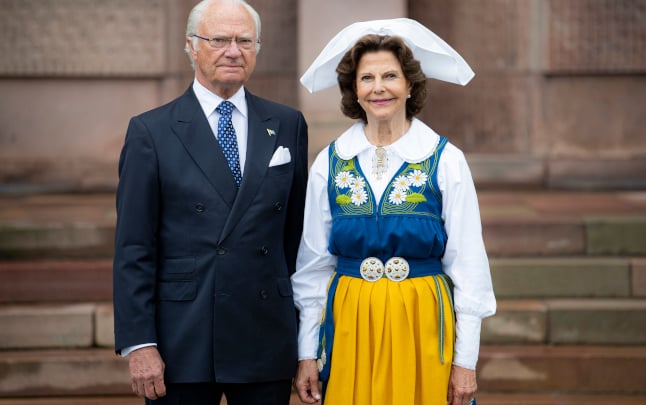
The King and Queen, who are both in their 70s, have had three Covid vaccinations each and have mild symptoms. They tested positive for Covid on Monday evening.
“The Royal couple have isolated themselves at home in accordance with the rules, and contact tracing is ongoing,” said the Royal Court in a statement on Tuesday afternoon.
The couple’s eldest daughter, Crown Princess Victoria, and her husband Prince Daniel had Covid in March last year.
Victoria’s brother, Prince Carl Philip, and his wife Princess Sofia, tested positive for Covid-19 in November 2020.
King and Queen of Sweden test positive for Covid-19
King Carl XVI Gustaf and Queen Silvia have both tested positive for Covid-19, the Royal Court of Sweden has confirmed.https://www.thelocal.se/20220104/king-and-queen-of-sweden-test-positive-for-covid-19/

The King and Queen, who are both in their 70s, have had three Covid vaccinations each and have mild symptoms. They tested positive for Covid on Monday evening.
“The Royal couple have isolated themselves at home in accordance with the rules, and contact tracing is ongoing,” said the Royal Court in a statement on Tuesday afternoon.
The couple’s eldest daughter, Crown Princess Victoria, and her husband Prince Daniel had Covid in March last year.
Victoria’s brother, Prince Carl Philip, and his wife Princess Sofia, tested positive for Covid-19 in November 2020.
January 4, 2022
It would take 56 THOUSAND (at 500K per year) Reiches one year to equal what Musk made in that 1 day
Your attempted 'kill the messenger' gambit to distract from the message is a fail.
January 4, 2022
https://www.theatlantic.com/newsletters/archive/2022/01/normcore-average-everyday-paradox/621110/

Like a suspenseful story or a taut tightrope, a good word can carry a sense of internal tension. This is most evident in a portmanteau, where multiple words are smashed together to form a new word that combines their meanings (it’s named after the portmanteau suitcase, which opens into two separate compartments). Bromance, labradoodle, Chamillionaire: A collision of two words yields a natural sense of drama. What’s going to come of the romance between these bros? What happens when you breed a Labrador and a poodle? How does a chameleon become a millionaire? Portmanteau words are like linguistic sitcoms—the more unlikely the pairing, the funnier they become. Which is why I always loved the word normcore.
For those of you who haven’t been keeping abreast of popular fashion trends for the past 10 or so years, normcore was a short-lived but widely discussed movement in the mid-2010s. Its aesthetic ideal, as the name suggests, was maximal blandness. Jeans, a monochromatic T-shirt, sneakers: The distinctive aspect of normcore style was a commitment to indistinction. The coolness of anti-cool. First coined by the trend-forecasting collective K-Hole in 2013, the term has since been wrung dry by the social media–media industrial complex through countless think pieces, analyses, and, eventually, a formal introduction into the lexicon.
But my morbid interest in normcore half a decade later comes from the beautiful drama of the portmanteau. This particular suitcase of a word opens up into norm and core, two very different compartments. Norm, meaning something standard, basic, or socially acceptable, comes to us from the Latin norma, a unit of measurement used in ancient Roman carpentry. Core, meanwhile, when used after hard, denotes the gritty center of something, and came to modern parlance in the middle of the 20th century through explicit pornography. The fragment -core eventually became detached from hard- to denote the fiercest advocates of an artistic movement, such as grindcore music, mumblecore movies, or clowncore … clowns. The composite normcore creates a paradoxical juxtaposition, and a compelling narrative question: How can something be normal in the extreme?
The answer, I believe, has to do with contrast. In the early 2010s, pre-normcore, there was an intense emphasis on individualism in personal style. Social-media marketing encouraged us to use our profiles to stand out by leaning into our “authentic” personal brands (if only to create more markets to cater to). But this obsession with aesthetic uniqueness soon became boring—we longed to look the same. A new era of fashion focused on homogeny: Kanye West’s monochromatic Yeezy shows, the reproducible plainness of streetwear, and, of course, normcore, which exhibited a lack of personal style that, in contrast with the individualistic look-at-me style that preceded it, seemed pretty hard-core. Hence the Thursday clue: “Style characterized by extreme blandness.”
snip
my adds:
2013-2016 examples, plus the 2003 progenitor
Cayce Pollard is the fictional protagonist of William Gibson's 2003 novel Pattern Recognition. She is the archetypal ur normcore persona.
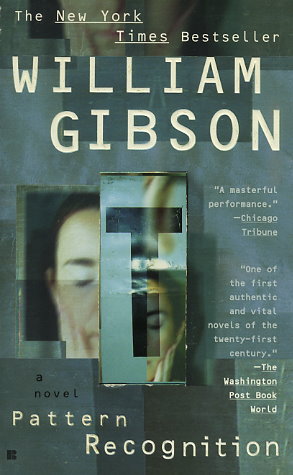
—?Pattern Recognition, 2. "Bitch", page 8.
As a consequence of her sensitivity, Cayce dresses in plain clothing she has either bought or rendered unadorned with brand markings of any kind (one possible exception is her "Luggage Label" hip bag, bought from Parco in Tokyo). These are referred to as "Cayce Pollard Units" or C.P.U.s, a term initially used by her friend Damien, and subsequently by Cayce, although never aloud. They are typically Fruit of the Loom shrunken cotton T-shirts worn with black oversized Levi's 501s, skirts, tights, boots, and a Buzz Rickson MA-1 bomber jacket.
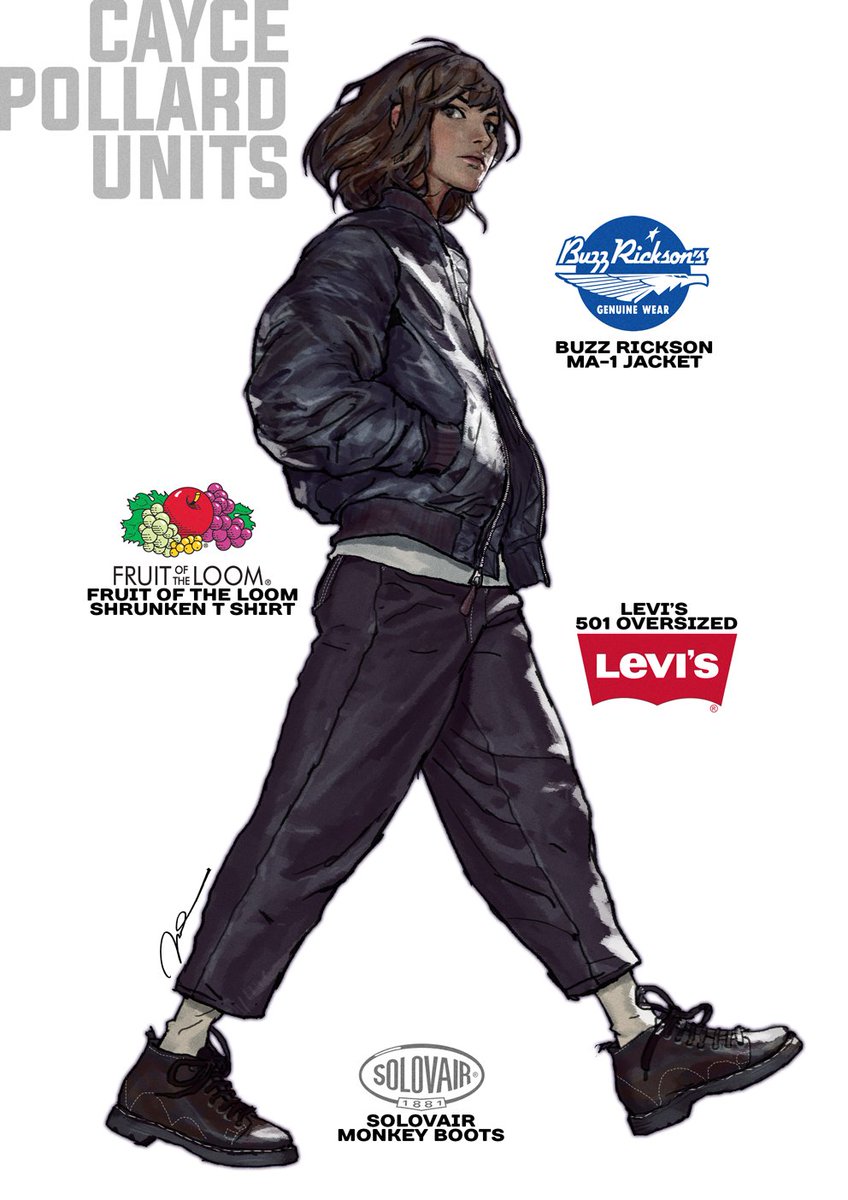
BUZZ RICKSON X WILLIAM GIBSON MA-1
https://www.historypreservation.com/products-page/brands/buzz-ricksons-william-gibson-collection-black-ma-1-intermediate-flying-jacket-modified-tailored-cut/

https://www.selfedge.com/index.php?route=product/product&product_id=647
The U. S. Air Force MA-1 Intermediate Flying Jacket was introduced as a descendant of the "modified" B-15D Flying Jacket in 1957. These early MA-1 jackets were made of a grayish shade of sage green heavy nylon twill fabric, warmly lined with woolen fiber filling sandwiched between the outer nylon shell and the sage green inner nylon lining. Later MA-1"s produced in the 1960"s declined in quality and warmth and featured a reversible orange lining. Buzz Rickson has offered an absolutely magnificent copy of the first-pattern MA-1 Flying Jacket ever since they began making historical clothing in 1994.
Early in 2003, best-selling novelist William Gibson released a groundbreaking new book by the name of "Pattern Recognition". This novel is set in the period immediately following "9-11", featuring a high-tech, super-hip, cyber-chic, anti-fashion marketing agent, Cayce Pollard, as the heroine. Woven within the many pages of cutting-edge writing Mr. Gibson has crafted is the one object more valued by Cayce Pollard than any other she owns" the Black Buzz Rickson MA-1 Flying Jacket.
William Gibson is an author of great talent and exceptionally good taste. Vintage clothing represents an area of personal interest to him, this especially includes wrist watches, MA-1 jackets, and the 1950 fishtail parka of the U. S. Army. He is a great admirer of the goods produced by Buzz Rickson, which is what provided the inspiration for the fictionalized Buzz Rickson Black MA-1 Jacket worn by this central character. Mysteriously, in the course of writing his novel, Mr. Gibson forgot that no MA-1"s were ever produced for the USAF in black.
The marketing team at Buzz Rickson in Japan was looking for a very unique and special item to acknowledge their tenth anniversary in 2004. Sometime in 2002, just as William Gibson was simultaneously giving life to the Buzz Rickson Black MA-1, Buzz Rickson was giving life to their tenth anniversary jacket - a special limited edition MA-1 fabricated in jet black.
Built with the same attention to detail that made Buzz Rickson a brand some Japanese customers wait well over a year to obtain and assembled out of authentic vintage-spec., we are happy to offer all those dedicated and uniquely anti-fashion fans of Pattern Recognition the Buzz Rickson Black MA-1. Buzz Rickson has agreed to use their 1957 Lion Uniform Company MA-1 as the basis for this garment, made with original spec. heavy nylon twill (but now in black), heavy-duty Crown?? zippers and devoid of any USAF markings other than the Buzz Rickson"s MA-1 spec. label in the lining, just as Cayce Pollard would have had it. Other than the color, this MA-1 is identical to the first-pattern MA-1 issued to the USAF, and exactly what William Gibson had in mind for Cayce. This MA-1 is a limited edition with finite stocks available.
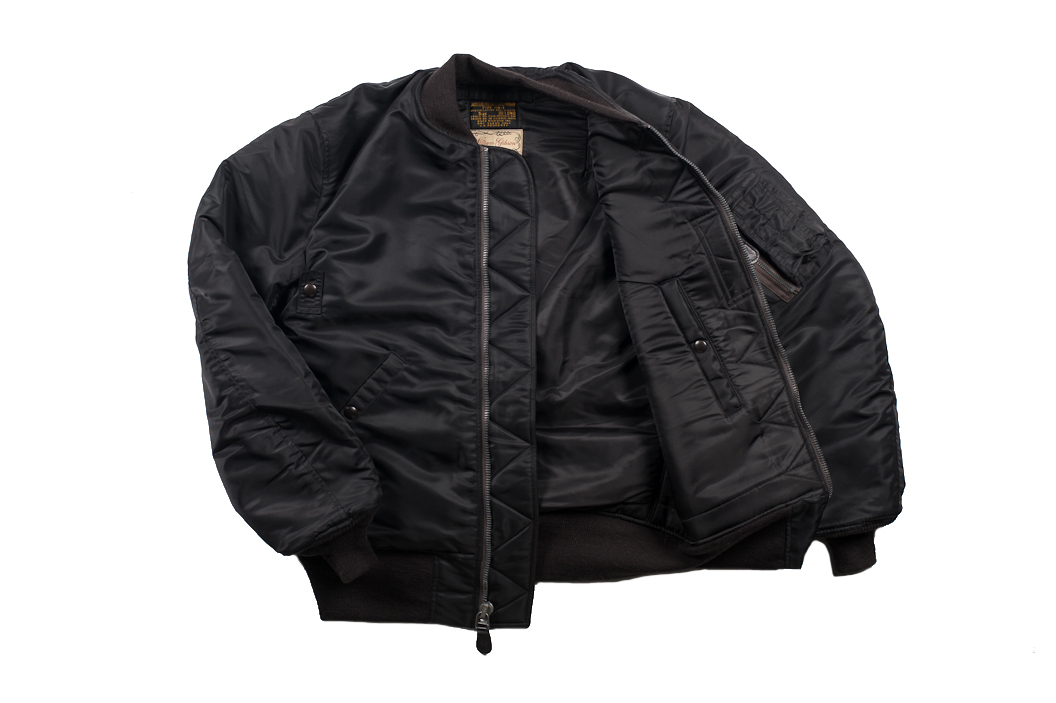
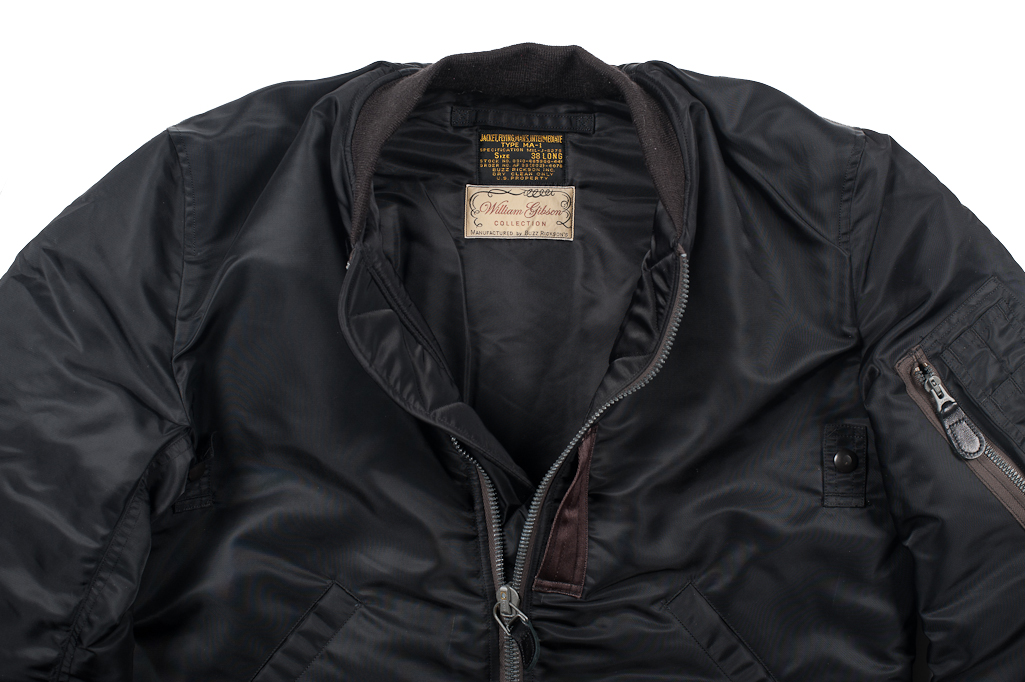








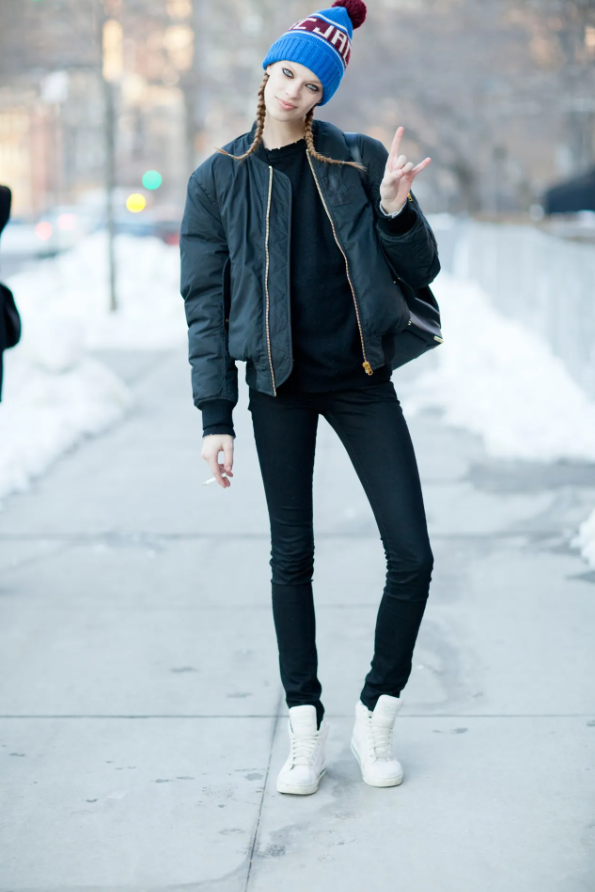

Normcore: Just Your Average, Everyday Paradox
The impossible tension of an anti-fashion portmanteauhttps://www.theatlantic.com/newsletters/archive/2022/01/normcore-average-everyday-paradox/621110/

Like a suspenseful story or a taut tightrope, a good word can carry a sense of internal tension. This is most evident in a portmanteau, where multiple words are smashed together to form a new word that combines their meanings (it’s named after the portmanteau suitcase, which opens into two separate compartments). Bromance, labradoodle, Chamillionaire: A collision of two words yields a natural sense of drama. What’s going to come of the romance between these bros? What happens when you breed a Labrador and a poodle? How does a chameleon become a millionaire? Portmanteau words are like linguistic sitcoms—the more unlikely the pairing, the funnier they become. Which is why I always loved the word normcore.
For those of you who haven’t been keeping abreast of popular fashion trends for the past 10 or so years, normcore was a short-lived but widely discussed movement in the mid-2010s. Its aesthetic ideal, as the name suggests, was maximal blandness. Jeans, a monochromatic T-shirt, sneakers: The distinctive aspect of normcore style was a commitment to indistinction. The coolness of anti-cool. First coined by the trend-forecasting collective K-Hole in 2013, the term has since been wrung dry by the social media–media industrial complex through countless think pieces, analyses, and, eventually, a formal introduction into the lexicon.
But my morbid interest in normcore half a decade later comes from the beautiful drama of the portmanteau. This particular suitcase of a word opens up into norm and core, two very different compartments. Norm, meaning something standard, basic, or socially acceptable, comes to us from the Latin norma, a unit of measurement used in ancient Roman carpentry. Core, meanwhile, when used after hard, denotes the gritty center of something, and came to modern parlance in the middle of the 20th century through explicit pornography. The fragment -core eventually became detached from hard- to denote the fiercest advocates of an artistic movement, such as grindcore music, mumblecore movies, or clowncore … clowns. The composite normcore creates a paradoxical juxtaposition, and a compelling narrative question: How can something be normal in the extreme?
The answer, I believe, has to do with contrast. In the early 2010s, pre-normcore, there was an intense emphasis on individualism in personal style. Social-media marketing encouraged us to use our profiles to stand out by leaning into our “authentic” personal brands (if only to create more markets to cater to). But this obsession with aesthetic uniqueness soon became boring—we longed to look the same. A new era of fashion focused on homogeny: Kanye West’s monochromatic Yeezy shows, the reproducible plainness of streetwear, and, of course, normcore, which exhibited a lack of personal style that, in contrast with the individualistic look-at-me style that preceded it, seemed pretty hard-core. Hence the Thursday clue: “Style characterized by extreme blandness.”
snip
my adds:
2013-2016 examples, plus the 2003 progenitor
Cayce Pollard is the fictional protagonist of William Gibson's 2003 novel Pattern Recognition. She is the archetypal ur normcore persona.

CPUs for the meeting, reflected in the window of a Soho specialist in mod paraphernalia, are a fresh Fruit T-shirt, her black Buzz Rickson's MA-1, anonymous black skirt from a Tulsa thrift, the black leggings she'd worn for Pilates, black Harajuku schoolgirl shoes. Her purse-analog is an envelope of black East German laminate, purchased on eBay if not actual Stasi-issue then well in the ballpark. She sees her own gray eyes, pale in the glass, and beyond them Ben Sherman shirts and fishtail parkas, cufflinks in the form of the RAF roundel that marked the wings of Spitfires.
CPUs. Cayce Pollard Units. That's what Damien calls the clothing she wears. CPUs are either black, white, or gray, and ideally seem to have come into this world without human intervention.
What people take for relentless minimalism is a side effect of too much exposure to the reactor-cores of fashion. This has resulted in a remorseless paring-down of what she can and will wear. She is, literally, allergic to fashion. She can only tolerate things that could have been worn, to a general lack of comment, during any year between 1945 and 2000. She’s a design-free zone, a one-woman school of anti whose very austerity periodically threatens to spawn its own cult.
—?Pattern Recognition, 2. "Bitch", page 8.
As a consequence of her sensitivity, Cayce dresses in plain clothing she has either bought or rendered unadorned with brand markings of any kind (one possible exception is her "Luggage Label" hip bag, bought from Parco in Tokyo). These are referred to as "Cayce Pollard Units" or C.P.U.s, a term initially used by her friend Damien, and subsequently by Cayce, although never aloud. They are typically Fruit of the Loom shrunken cotton T-shirts worn with black oversized Levi's 501s, skirts, tights, boots, and a Buzz Rickson MA-1 bomber jacket.

BUZZ RICKSON X WILLIAM GIBSON MA-1
https://www.historypreservation.com/products-page/brands/buzz-ricksons-william-gibson-collection-black-ma-1-intermediate-flying-jacket-modified-tailored-cut/

https://www.selfedge.com/index.php?route=product/product&product_id=647
The U. S. Air Force MA-1 Intermediate Flying Jacket was introduced as a descendant of the "modified" B-15D Flying Jacket in 1957. These early MA-1 jackets were made of a grayish shade of sage green heavy nylon twill fabric, warmly lined with woolen fiber filling sandwiched between the outer nylon shell and the sage green inner nylon lining. Later MA-1"s produced in the 1960"s declined in quality and warmth and featured a reversible orange lining. Buzz Rickson has offered an absolutely magnificent copy of the first-pattern MA-1 Flying Jacket ever since they began making historical clothing in 1994.
Early in 2003, best-selling novelist William Gibson released a groundbreaking new book by the name of "Pattern Recognition". This novel is set in the period immediately following "9-11", featuring a high-tech, super-hip, cyber-chic, anti-fashion marketing agent, Cayce Pollard, as the heroine. Woven within the many pages of cutting-edge writing Mr. Gibson has crafted is the one object more valued by Cayce Pollard than any other she owns" the Black Buzz Rickson MA-1 Flying Jacket.
William Gibson is an author of great talent and exceptionally good taste. Vintage clothing represents an area of personal interest to him, this especially includes wrist watches, MA-1 jackets, and the 1950 fishtail parka of the U. S. Army. He is a great admirer of the goods produced by Buzz Rickson, which is what provided the inspiration for the fictionalized Buzz Rickson Black MA-1 Jacket worn by this central character. Mysteriously, in the course of writing his novel, Mr. Gibson forgot that no MA-1"s were ever produced for the USAF in black.
The marketing team at Buzz Rickson in Japan was looking for a very unique and special item to acknowledge their tenth anniversary in 2004. Sometime in 2002, just as William Gibson was simultaneously giving life to the Buzz Rickson Black MA-1, Buzz Rickson was giving life to their tenth anniversary jacket - a special limited edition MA-1 fabricated in jet black.
Built with the same attention to detail that made Buzz Rickson a brand some Japanese customers wait well over a year to obtain and assembled out of authentic vintage-spec., we are happy to offer all those dedicated and uniquely anti-fashion fans of Pattern Recognition the Buzz Rickson Black MA-1. Buzz Rickson has agreed to use their 1957 Lion Uniform Company MA-1 as the basis for this garment, made with original spec. heavy nylon twill (but now in black), heavy-duty Crown?? zippers and devoid of any USAF markings other than the Buzz Rickson"s MA-1 spec. label in the lining, just as Cayce Pollard would have had it. Other than the color, this MA-1 is identical to the first-pattern MA-1 issued to the USAF, and exactly what William Gibson had in mind for Cayce. This MA-1 is a limited edition with finite stocks available.












January 4, 2022
https://www.nytimes.com/2022/01/03/us/politics/midterm-elections-coronavirus.html
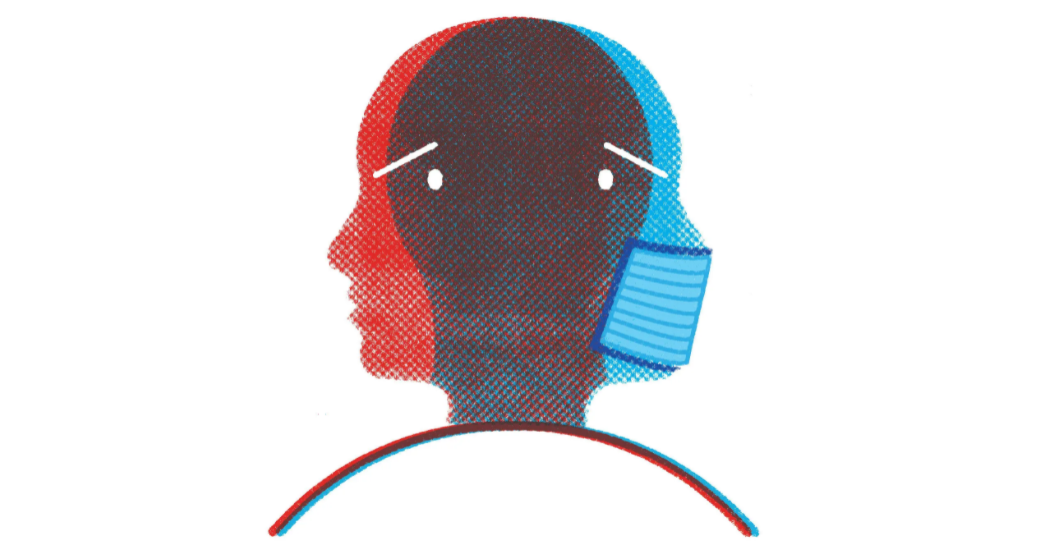
Tough choices all around
The Omicron variant of the coronavirus struck at the most inconvenient time: just as millions of Americans were traveling for the Christmas and New Year holidays. Suddenly, family gatherings were once again shadowed by menace and risk of infection — but also by a new layer of uncertainty and confusion. All of which served to drive Americans to new heights of exhaustion with the toll the virus has taken on ordinary life. It remains a serious public health emergency, with daily coronavirus cases soaring into the hundreds of thousands.
But the pandemic also presents difficult political choices for elected officials, from President Biden on down, just as election season begins in earnest. Democrats could enter the 2022 midterms as the responsible grown-ups who finally tamed a deadly scourge. Or, if Republicans succeed in branding mask and vaccine mandates as nanny-state overreach, voters could punish them in the fall. Most likely, both narratives will compete for attention as the virus itself casts the determining vote. “Everyone up and down the chain is frustrated,” said Frank Luntz, a Republican messaging expert who has spent the last year conducting focus groups on the virus. “And it just doesn’t seem to end.”
Worn out, fed up and confused
There is no mistaking the signals that Americans are sending at this moment: A Monmouth University poll taken two weeks after Omicron was first detected in the United States found that six in 10 Americans said they were “worn out” by the pandemic, and nearly half said they were angry. Since January 2021, the public’s initial exuberance about the arrival of vaccines has curdled. More than 58 percent reported feeling “frustrated” about the status of Covid vaccinations in a recent Kaiser Family Foundation poll. A quarter said they were “confused.”
According to Gallup’s Covid tracking survey, optimism about the state of the pandemic reached 51 percent in October only to plummet to 31 percent in December. The percentage of Americans who said the situation had gotten worse shot up to 35 percent from 18 percent. But polls also show a deep divide between those vaccinated and not, and Omicron has barely budged the latter. “As a nation, we’re not experiencing the pandemic equally,” said [link:MollyB@kff.org|Mollyann Brodie], who oversees polling for the Kaiser Family Foundation.
Science vs. impatience.......
snip
A Frazzled America Staggers Into 2022
The Omicron variant’s spread poses an unwelcome political conundrum just as election season begins. Democrats and the G.O.P. see reasons to hope, but the virus will get the decidinghttps://www.nytimes.com/2022/01/03/us/politics/midterm-elections-coronavirus.html

Tough choices all around
The Omicron variant of the coronavirus struck at the most inconvenient time: just as millions of Americans were traveling for the Christmas and New Year holidays. Suddenly, family gatherings were once again shadowed by menace and risk of infection — but also by a new layer of uncertainty and confusion. All of which served to drive Americans to new heights of exhaustion with the toll the virus has taken on ordinary life. It remains a serious public health emergency, with daily coronavirus cases soaring into the hundreds of thousands.
But the pandemic also presents difficult political choices for elected officials, from President Biden on down, just as election season begins in earnest. Democrats could enter the 2022 midterms as the responsible grown-ups who finally tamed a deadly scourge. Or, if Republicans succeed in branding mask and vaccine mandates as nanny-state overreach, voters could punish them in the fall. Most likely, both narratives will compete for attention as the virus itself casts the determining vote. “Everyone up and down the chain is frustrated,” said Frank Luntz, a Republican messaging expert who has spent the last year conducting focus groups on the virus. “And it just doesn’t seem to end.”
Worn out, fed up and confused
There is no mistaking the signals that Americans are sending at this moment: A Monmouth University poll taken two weeks after Omicron was first detected in the United States found that six in 10 Americans said they were “worn out” by the pandemic, and nearly half said they were angry. Since January 2021, the public’s initial exuberance about the arrival of vaccines has curdled. More than 58 percent reported feeling “frustrated” about the status of Covid vaccinations in a recent Kaiser Family Foundation poll. A quarter said they were “confused.”
According to Gallup’s Covid tracking survey, optimism about the state of the pandemic reached 51 percent in October only to plummet to 31 percent in December. The percentage of Americans who said the situation had gotten worse shot up to 35 percent from 18 percent. But polls also show a deep divide between those vaccinated and not, and Omicron has barely budged the latter. “As a nation, we’re not experiencing the pandemic equally,” said [link:MollyB@kff.org|Mollyann Brodie], who oversees polling for the Kaiser Family Foundation.
Science vs. impatience.......
snip
January 4, 2022
Drive Like Jehu was an American post-hardcore band from San Diego active from 1990 to 1995. Formed by rhythm guitarist and vocalist Rick Froberg and lead guitarist John Reis (also in Rocket From The Crypt) following the breakup of their band Pitchfork, the band's lineup also included bassist Mike Kennedy and drummer Mark Trombino. Their music was characterized by multi-sectioned compositions, interlocking guitar patterns, orchestrated builds and releases, and elliptical melodies that produced a distinctive sound amongst other post-hardcore acts and impacted the evolution of hardcore punk into emo.
Tracklist
1 Here Come The Rome Plows 5:45
2 Do You Compute 7:13
3 Golden Brown 3:15
4 Luau 9:28
5 Super Unison 7:25
6 New Intro 3:32
7 New Math 4:06
8 Human Interest 3:24
9 Sinews 9:13
10 Hand Over Fist 4:24
11 Bullet Train To Vegas 2:40
12 Sinews (Original Version) 9:33
Label: Swami Records – SWA115, Swami Records – SW115
Format:
CD, Album, Reissue
Country: US
Released: 2002
Genre: Rock
Style: Punk, Indie Rock




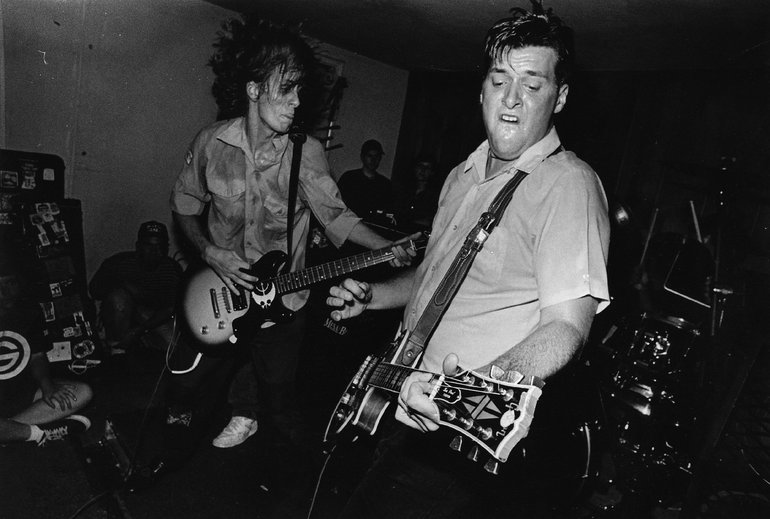



Drive Like Jehu - Yank Crime - 2002 Deluxe Reissue of the 1994 LP (Full Album)
Drive Like Jehu was an American post-hardcore band from San Diego active from 1990 to 1995. Formed by rhythm guitarist and vocalist Rick Froberg and lead guitarist John Reis (also in Rocket From The Crypt) following the breakup of their band Pitchfork, the band's lineup also included bassist Mike Kennedy and drummer Mark Trombino. Their music was characterized by multi-sectioned compositions, interlocking guitar patterns, orchestrated builds and releases, and elliptical melodies that produced a distinctive sound amongst other post-hardcore acts and impacted the evolution of hardcore punk into emo.
Tracklist
1 Here Come The Rome Plows 5:45
2 Do You Compute 7:13
3 Golden Brown 3:15
4 Luau 9:28
5 Super Unison 7:25
6 New Intro 3:32
7 New Math 4:06
8 Human Interest 3:24
9 Sinews 9:13
10 Hand Over Fist 4:24
11 Bullet Train To Vegas 2:40
12 Sinews (Original Version) 9:33
Label: Swami Records – SWA115, Swami Records – SW115
Format:
CD, Album, Reissue
Country: US
Released: 2002
Genre: Rock
Style: Punk, Indie Rock








January 3, 2022
Label: Capitol Records – SPRO-11230
Format:
Vinyl, 10", 33 ⅓ RPM, Single, Promo
Country: US
Released: 1996
Genre: Electronic, Hip Hop, Rock
Style: Alternative Rock
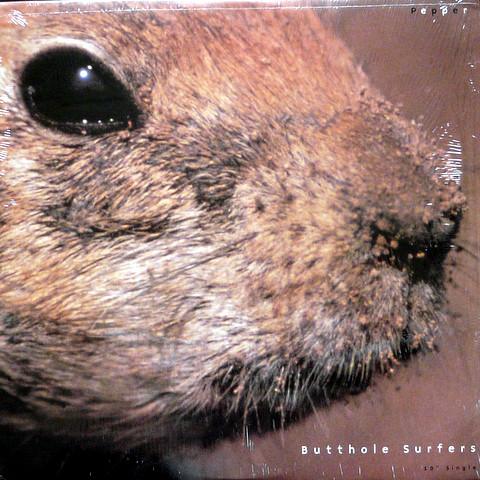


Butthole Surfers - Pepper
Label: Capitol Records – SPRO-11230
Format:
Vinyl, 10", 33 ⅓ RPM, Single, Promo
Country: US
Released: 1996
Genre: Electronic, Hip Hop, Rock
Style: Alternative Rock



January 3, 2022
https://www.nytimes.com/2022/01/03/technology/apple-3-trillion-market-value.html

Combine Walmart, Disney, Netflix, Nike, Exxon Mobil, Coca-Cola, Comcast, Morgan Stanley, McDonald’s, AT&T, Goldman Sachs, Boeing, IBM and Ford. Apple is still worth more.
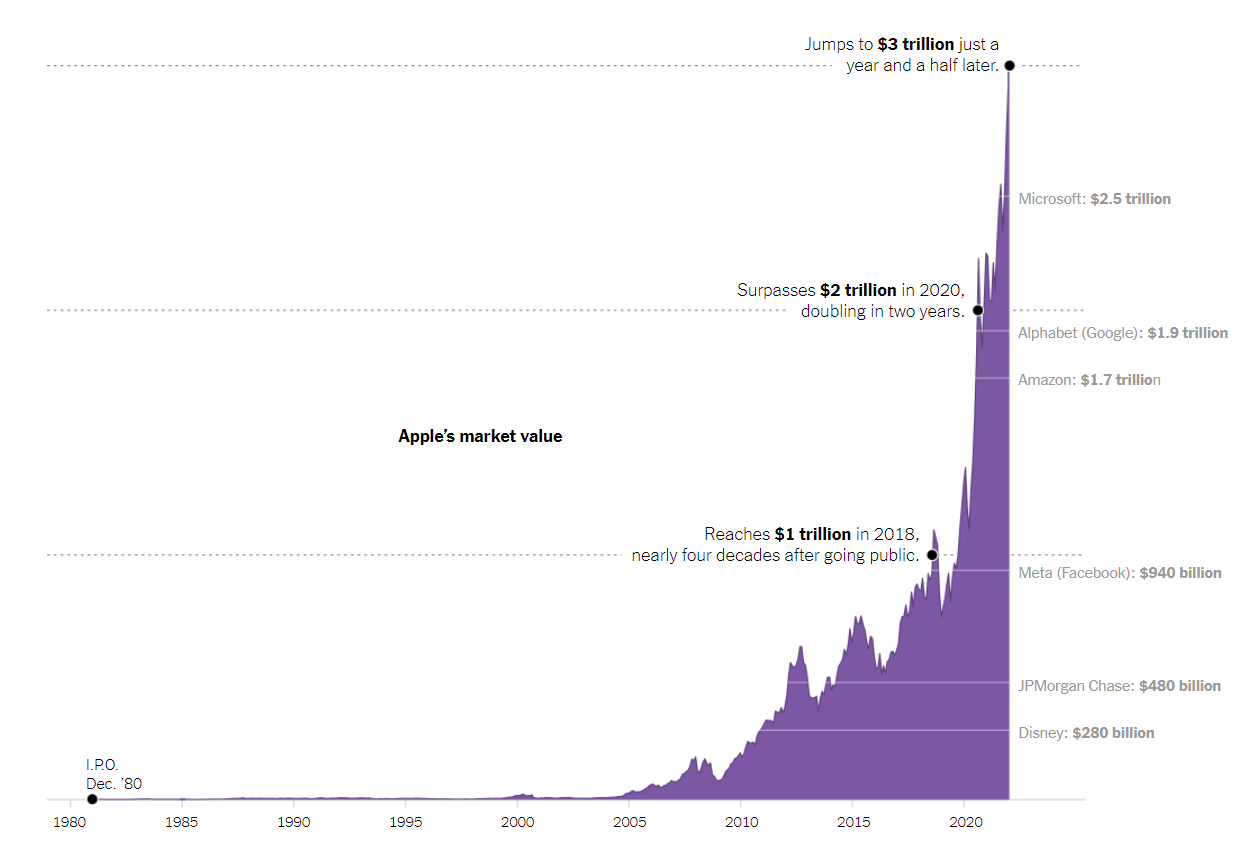
Apple, the computer company that started in a California garage in 1976, is now worth $3 trillion. It became the first publicly traded company to ever reach the figure on Monday, when its stock briefly eclipsed $182.86 a share before closing at $182.01.
Apple’s value is even more remarkable considering how rapid its recent ascent has been. In August 2018, Apple became the first American company ever to be worth $1 trillion, an achievement that took 42 years. It surged past $2 trillion two years later. Its next trillion took just 16 months and 15 days.
Such a valuation would have been unfathomable a few years ago. Now it seems like another milepost for a corporate titan that is still growing and appears to have few tall hurdles in its path. Another tech giant, Microsoft, could follow Apple into the $3 trillion club early this year.
snip
Apple Becomes First Company to Hit $3 Trillion Market Value
The iPhone maker’s value tripled since 2018 as its sales continued to soar and it spent hundreds of billions of dollars on its own stock.https://www.nytimes.com/2022/01/03/technology/apple-3-trillion-market-value.html

Combine Walmart, Disney, Netflix, Nike, Exxon Mobil, Coca-Cola, Comcast, Morgan Stanley, McDonald’s, AT&T, Goldman Sachs, Boeing, IBM and Ford. Apple is still worth more.

Apple, the computer company that started in a California garage in 1976, is now worth $3 trillion. It became the first publicly traded company to ever reach the figure on Monday, when its stock briefly eclipsed $182.86 a share before closing at $182.01.
Apple’s value is even more remarkable considering how rapid its recent ascent has been. In August 2018, Apple became the first American company ever to be worth $1 trillion, an achievement that took 42 years. It surged past $2 trillion two years later. Its next trillion took just 16 months and 15 days.
Such a valuation would have been unfathomable a few years ago. Now it seems like another milepost for a corporate titan that is still growing and appears to have few tall hurdles in its path. Another tech giant, Microsoft, could follow Apple into the $3 trillion club early this year.
snip
Profile Information
Gender: FemaleHometown: London
Home country: US/UK/Sweden
Current location: Stockholm, Sweden
Member since: Sun Jul 1, 2018, 07:25 PM
Number of posts: 43,299
